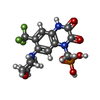[English] 日本語
 Yorodumi
Yorodumi- PDB-7rz5: Structure of the complex of LBD-TMD part of AMPA receptor GluA2 w... -
+ Open data
Open data
- Basic information
Basic information
| Entry | Database: PDB / ID: 7rz5 | |||||||||||||||
|---|---|---|---|---|---|---|---|---|---|---|---|---|---|---|---|---|
| Title | Structure of the complex of LBD-TMD part of AMPA receptor GluA2 with auxiliary subunit TARP gamma-5 bound to competitive antagonist ZK 200775 | |||||||||||||||
 Components Components | Glutamate receptor 2 GRIA2 GRIA2 | |||||||||||||||
 Keywords Keywords |  MEMBRANE PROTEIN / MEMBRANE PROTEIN /  AMPA receptor / AMPA receptor /  ion channel / ion channel /  neurotransmission / neurotransmission /  synapse / TARP gamma-5 synapse / TARP gamma-5 | |||||||||||||||
| Function / homology |  Function and homology information Function and homology informationspine synapse / dendritic spine neck / dendritic spine head / Activation of AMPA receptors / response to lithium ion / perisynaptic space / cellular response to glycine / AMPA glutamate receptor activity / Trafficking of GluR2-containing AMPA receptors /  immunoglobulin binding ...spine synapse / dendritic spine neck / dendritic spine head / Activation of AMPA receptors / response to lithium ion / perisynaptic space / cellular response to glycine / AMPA glutamate receptor activity / Trafficking of GluR2-containing AMPA receptors / immunoglobulin binding ...spine synapse / dendritic spine neck / dendritic spine head / Activation of AMPA receptors / response to lithium ion / perisynaptic space / cellular response to glycine / AMPA glutamate receptor activity / Trafficking of GluR2-containing AMPA receptors /  immunoglobulin binding / AMPA glutamate receptor complex / kainate selective glutamate receptor activity / immunoglobulin binding / AMPA glutamate receptor complex / kainate selective glutamate receptor activity /  ionotropic glutamate receptor complex / extracellularly glutamate-gated ion channel activity / asymmetric synapse / regulation of receptor recycling / Unblocking of NMDA receptors, glutamate binding and activation / ionotropic glutamate receptor complex / extracellularly glutamate-gated ion channel activity / asymmetric synapse / regulation of receptor recycling / Unblocking of NMDA receptors, glutamate binding and activation /  glutamate receptor binding / positive regulation of synaptic transmission / presynaptic active zone membrane / glutamate-gated receptor activity / response to fungicide / glutamate receptor binding / positive regulation of synaptic transmission / presynaptic active zone membrane / glutamate-gated receptor activity / response to fungicide /  regulation of synaptic transmission, glutamatergic / cellular response to brain-derived neurotrophic factor stimulus / somatodendritic compartment / dendrite membrane / ligand-gated monoatomic ion channel activity involved in regulation of presynaptic membrane potential / regulation of synaptic transmission, glutamatergic / cellular response to brain-derived neurotrophic factor stimulus / somatodendritic compartment / dendrite membrane / ligand-gated monoatomic ion channel activity involved in regulation of presynaptic membrane potential /  ionotropic glutamate receptor binding / ionotropic glutamate receptor signaling pathway / ionotropic glutamate receptor binding / ionotropic glutamate receptor signaling pathway /  cytoskeletal protein binding / dendrite cytoplasm / cytoskeletal protein binding / dendrite cytoplasm /  SNARE binding / dendritic shaft / transmitter-gated monoatomic ion channel activity involved in regulation of postsynaptic membrane potential / SNARE binding / dendritic shaft / transmitter-gated monoatomic ion channel activity involved in regulation of postsynaptic membrane potential /  synaptic membrane / synaptic membrane /  synaptic transmission, glutamatergic / synaptic transmission, glutamatergic /  PDZ domain binding / protein tetramerization / postsynaptic density membrane / modulation of chemical synaptic transmission / Schaffer collateral - CA1 synapse / establishment of protein localization / PDZ domain binding / protein tetramerization / postsynaptic density membrane / modulation of chemical synaptic transmission / Schaffer collateral - CA1 synapse / establishment of protein localization /  terminal bouton / terminal bouton /  receptor internalization / synaptic vesicle membrane / cerebral cortex development / receptor internalization / synaptic vesicle membrane / cerebral cortex development /  synaptic vesicle / presynapse / synaptic vesicle / presynapse /  signaling receptor activity / signaling receptor activity /  presynaptic membrane / presynaptic membrane /  amyloid-beta binding / amyloid-beta binding /  growth cone / growth cone /  perikaryon / chemical synaptic transmission / perikaryon / chemical synaptic transmission /  scaffold protein binding / scaffold protein binding /  postsynaptic membrane / postsynaptic membrane /  dendritic spine / dendritic spine /  postsynaptic density / neuron projection / postsynaptic density / neuron projection /  axon / neuronal cell body / axon / neuronal cell body /  dendrite / dendrite /  synapse / glutamatergic synapse / protein-containing complex binding / endoplasmic reticulum membrane / synapse / glutamatergic synapse / protein-containing complex binding / endoplasmic reticulum membrane /  protein kinase binding / protein kinase binding /  cell surface / cell surface /  endoplasmic reticulum / protein-containing complex / endoplasmic reticulum / protein-containing complex /  membrane / identical protein binding / membrane / identical protein binding /  plasma membrane plasma membraneSimilarity search - Function | |||||||||||||||
| Biological species |   Rattus norvegicus (Norway rat) Rattus norvegicus (Norway rat) | |||||||||||||||
| Method |  ELECTRON MICROSCOPY / ELECTRON MICROSCOPY /  single particle reconstruction / single particle reconstruction /  cryo EM / Resolution: 3.3 Å cryo EM / Resolution: 3.3 Å | |||||||||||||||
 Authors Authors | Gangwar, S.P. / Klykov, O.V. / Yelshanskaya, M.V. / Sobolevsky, A.I. | |||||||||||||||
| Funding support |  United States, 4items United States, 4items
| |||||||||||||||
 Citation Citation |  Journal: Mol Cell / Year: 2021 Journal: Mol Cell / Year: 2021Title: Structure and desensitization of AMPA receptor complexes with type II TARP γ5 and GSG1L. Authors: Oleg Klykov / Shanti Pal Gangwar / Maria V Yelshanskaya / Laura Yen / Alexander I Sobolevsky /  Abstract: AMPA receptors (AMPARs) mediate the majority of excitatory neurotransmission. Their surface expression, trafficking, gating, and pharmacology are regulated by auxiliary subunits. Of the two types of ...AMPA receptors (AMPARs) mediate the majority of excitatory neurotransmission. Their surface expression, trafficking, gating, and pharmacology are regulated by auxiliary subunits. Of the two types of TARP auxiliary subunits, type I TARPs assume activating roles, while type II TARPs serve suppressive functions. We present cryo-EM structures of GluA2 AMPAR in complex with type II TARP γ5, which reduces steady-state currents, increases single-channel conductance, and slows recovery from desensitization. Regulation of AMPAR function depends on its ligand-binding domain (LBD) interaction with the γ5 head domain. GluA2-γ5 complex shows maximum stoichiometry of two TARPs per AMPAR tetramer, being different from type I TARPs but reminiscent of the auxiliary subunit GSG1L. Desensitization of both GluA2-GSG1L and GluA2-γ5 complexes is accompanied by rupture of LBD dimer interface, while GluA2-γ5 but not GluA2-GSG1L LBD dimers remain two-fold symmetric. Different structural architectures and desensitization mechanisms of complexes with auxiliary subunits endow AMPARs with broad functional capabilities. | |||||||||||||||
| History |
|
- Structure visualization
Structure visualization
| Movie |
 Movie viewer Movie viewer |
|---|---|
| Structure viewer | Molecule:  Molmil Molmil Jmol/JSmol Jmol/JSmol |
- Downloads & links
Downloads & links
- Download
Download
| PDBx/mmCIF format |  7rz5.cif.gz 7rz5.cif.gz | 418.2 KB | Display |  PDBx/mmCIF format PDBx/mmCIF format |
|---|---|---|---|---|
| PDB format |  pdb7rz5.ent.gz pdb7rz5.ent.gz | 327.9 KB | Display |  PDB format PDB format |
| PDBx/mmJSON format |  7rz5.json.gz 7rz5.json.gz | Tree view |  PDBx/mmJSON format PDBx/mmJSON format | |
| Others |  Other downloads Other downloads |
-Validation report
| Arichive directory |  https://data.pdbj.org/pub/pdb/validation_reports/rz/7rz5 https://data.pdbj.org/pub/pdb/validation_reports/rz/7rz5 ftp://data.pdbj.org/pub/pdb/validation_reports/rz/7rz5 ftp://data.pdbj.org/pub/pdb/validation_reports/rz/7rz5 | HTTPS FTP |
|---|
-Related structure data
| Related structure data |  24751MC  7ryyC  7ryzC  7rz4C  7rz6C  7rz7C  7rz8C  7rz9C  7rzaC M: map data used to model this data C: citing same article ( |
|---|---|
| Similar structure data |
- Links
Links
- Assembly
Assembly
| Deposited unit | 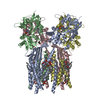
|
|---|---|
| 1 |
|
- Components
Components
| #1: Protein |  GRIA2 / GluR-2 / AMPA-selective glutamate receptor 2 / GluR-B / GluR-K2 / Glutamate receptor ionotropic / ...GluR-2 / AMPA-selective glutamate receptor 2 / GluR-B / GluR-K2 / Glutamate receptor ionotropic / AMPA 2 / GluA2 GRIA2 / GluR-2 / AMPA-selective glutamate receptor 2 / GluR-B / GluR-K2 / Glutamate receptor ionotropic / ...GluR-2 / AMPA-selective glutamate receptor 2 / GluR-B / GluR-K2 / Glutamate receptor ionotropic / AMPA 2 / GluA2Mass: 116018.000 Da / Num. of mol.: 4 Source method: isolated from a genetically manipulated source Source: (gene. exp.)   Rattus norvegicus (Norway rat) / Gene: Gria2, Glur2 / Plasmid: BacMam / Cell line (production host): HEK293S-GnTi / Production host: Rattus norvegicus (Norway rat) / Gene: Gria2, Glur2 / Plasmid: BacMam / Cell line (production host): HEK293S-GnTi / Production host:   Homo sapiens (human) / References: UniProt: P19491 Homo sapiens (human) / References: UniProt: P19491#2: Chemical | ChemComp-ZK1 / {[  Fanapanel Fanapanel#3: Chemical | ChemComp-PCW / Has ligand of interest | Y | |
|---|
-Experimental details
-Experiment
| Experiment | Method:  ELECTRON MICROSCOPY ELECTRON MICROSCOPY |
|---|---|
| EM experiment | Aggregation state: PARTICLE / 3D reconstruction method:  single particle reconstruction single particle reconstruction |
- Sample preparation
Sample preparation
| Component | Name: GluA2 / Type: COMPLEX Details: Map displaying ligand binding, and transmembrane domain and auxiliary subunit TARP gamma-5 Entity ID: #1 / Source: RECOMBINANT | |||||||||||||||||||||||||
|---|---|---|---|---|---|---|---|---|---|---|---|---|---|---|---|---|---|---|---|---|---|---|---|---|---|---|
| Molecular weight | Experimental value: NO | |||||||||||||||||||||||||
| Source (natural) | Organism:   Rattus norvegicus (Norway rat) Rattus norvegicus (Norway rat) | |||||||||||||||||||||||||
| Source (recombinant) | Organism:   Homo sapiens (human) / Cell: HEK293S-GnTi / Plasmid Homo sapiens (human) / Cell: HEK293S-GnTi / Plasmid : BacMam : BacMam | |||||||||||||||||||||||||
| Buffer solution | pH: 8 | |||||||||||||||||||||||||
| Buffer component |
| |||||||||||||||||||||||||
| Specimen | Conc.: 4 mg/ml / Embedding applied: NO / Shadowing applied: NO / Staining applied : NO / Vitrification applied : NO / Vitrification applied : YES : YESDetails: Protein extracted and reconstituted in detergent micelle | |||||||||||||||||||||||||
| Specimen support | Grid material: GOLD / Grid mesh size: 300 divisions/in. / Grid type: C-flat-1.2/1.3 | |||||||||||||||||||||||||
Vitrification | Instrument: FEI VITROBOT MARK IV / Cryogen name: ETHANE / Humidity: 100 % / Chamber temperature: 277 K Details: 0.1mM ZK was added to the purified protein and incubated on ice for 30 min before sample preparation |
- Electron microscopy imaging
Electron microscopy imaging
| Experimental equipment |  Model: Titan Krios / Image courtesy: FEI Company |
|---|---|
| Microscopy | Model: FEI TITAN KRIOS |
| Electron gun | Electron source : :  FIELD EMISSION GUN / Accelerating voltage: 300 kV / Illumination mode: FLOOD BEAM FIELD EMISSION GUN / Accelerating voltage: 300 kV / Illumination mode: FLOOD BEAM |
| Electron lens | Mode: BRIGHT FIELD Bright-field microscopy Bright-field microscopy |
| Image recording | Average exposure time: 2.5 sec. / Electron dose: 62.5 e/Å2 / Film or detector model: GATAN K3 (6k x 4k) / Num. of grids imaged: 3 |
- Processing
Processing
| EM software |
| ||||||||||||
|---|---|---|---|---|---|---|---|---|---|---|---|---|---|
CTF correction | Type: NONE | ||||||||||||
| Particle selection | Num. of particles selected: 7073223 | ||||||||||||
| Symmetry | Point symmetry : C2 (2 fold cyclic : C2 (2 fold cyclic ) ) | ||||||||||||
3D reconstruction | Resolution: 3.3 Å / Resolution method: FSC 0.143 CUT-OFF / Num. of particles: 111527 / Symmetry type: POINT |
 Movie
Movie Controller
Controller










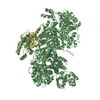
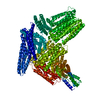


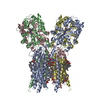
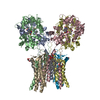


 PDBj
PDBj




